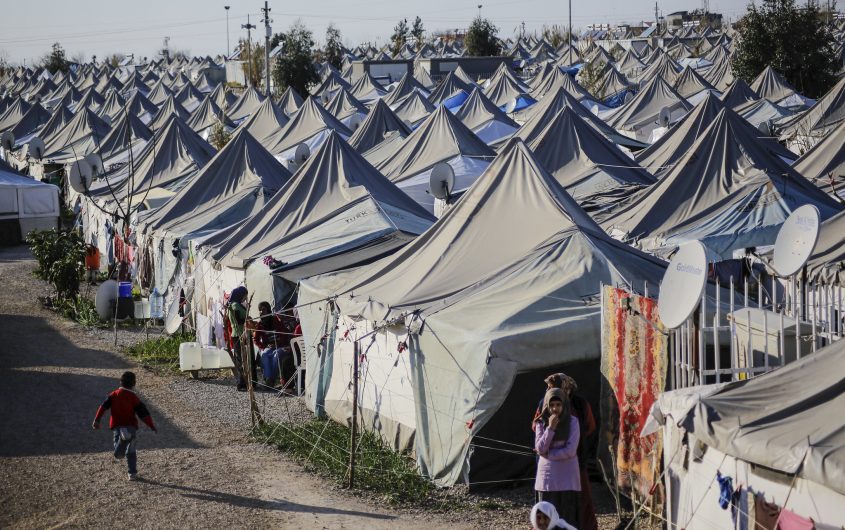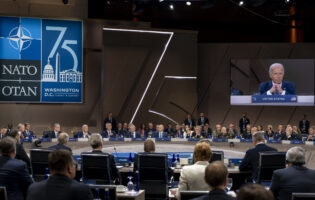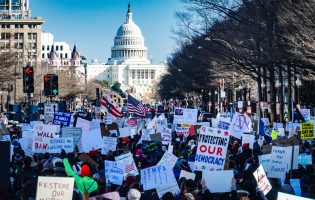
European Parliament via Flickr
Easier Said than Done – Still, Germany and the U.S. Need to Break the Cycle on Migration

Adam Hunter
Refugee Council USA
Adam Hunter is Executive Director of Refugee Council USA (RCUSA), an organization working to protect and welcome refugees, asylum seekers, and other forcibly displaced populations. With an engaged coalition of diverse members, he guides policy advocacy and promotes dialogue and cross-sector collaboration to advance excellence in resettlement and integration programs.
Adam has more than 15 years’ experience on migration, national security, and international affairs issues through positions in government, foundations, think tanks, and fellowships. Before RCUSA he was a Consultant advising philanthropic and non-profit leaders on policy and strategy. He was also Director of a Pew Charitable Trusts’ research project exploring immigration federalism. In government, Adam served as Acting Chief of Staff at U.S. Citizenship and Immigration Services (USCIS), a component of the Department of Homeland Security, and held prior agency leadership and program management roles. Earlier in his career, he worked with policymakers in Europe and at Washington think tanks, including the German Marshall Fund of the United States.
Adam has been a Robert Bosch Foundation fellow, Transatlantic Forum on Migration and Integration fellow, Atlantik-Brücke German-American young leader, and member of the BMW Foundation responsible leaders network. In addition, he is a fellow of the Truman National Security Project and founding U.S. chair of Metropolis North America, a trilateral U.S.-Canada-Mexico migration and border forum. He serves on the board of directors of Cultural Vistas, an international exchange organization. Adam holds a BA from Vanderbilt University, MPP from the Harvard Kennedy School, and D&I certificate from Cornell University. He is an avid language learner and lives with his husband in Washington, DC.
Looking back after five years, Germany’s relative success with the more than 1.1 million people who arrived in 2015 is a vindication of Chancellor Angela Merkel’s belief in Germany’s can-do “wir schaffen das” spirit. Her posture to welcome those seeking humanitarian protection is in stark contrast to President Trump, whose administration has used a range of approaches to undermine America’s refugee and asylum systems. At this summer’s press conference the German chancellor did not deviate from her policy, noting she would essentially make the same decisions all over again.
Beyond Germany’s headlining achievement, another look at the same five-year period with a wider lens reveals a broader challenge that many countries still face on migration policymaking. Critical to Germany’s success was that the rate of new arrivals sharply fell, allowing the German administrative state to reestablish order, process, and integration—but arrivals fell not because the push factors ended, but because refugees were cut off.
A Pattern Emerges
Migration policy can be reactive and follow a pattern. There’s a “crisis” that reveals a fundamental weakness, then a turning point compels action, and finally, that action pushes off, rather than resolves, the “crisis.”[1] This short-term approach to quell immediate migration pressure hopes the fundamental challenges go away. But in the end neither is the exposed weakness repaired, nor the crisis behind the migration adequately addressed.
In Europe, the sharp rise in migrants and asylum-seekers in 2015 was the “crisis” moment, but the fundamental weakness it revealed was not in the migration realm at all, but European solidarity. Key tenets of European solidarity and freedom of movement were under strain before 2015—recall the Eurozone crisis and how EU enlargement still means limited movement for new members’ citizens. But when German chancellor Angela Merkel suspended the Dublin agreement for Syrians and made her notable “wir schaffen das” statement in August 2015, she stood nearly alone among European leaders. In the weeks that followed, the Schengen Agreement was suspended, internal border checks imposed, and some countries—notably the Visegrad Four (Poland, Hungary, Slovakia, and the Czech Republic) —rejected accepting asylum-seekers, a posture that extends to this day. But as Germany sought to lead Europe and demonstrate its commitment both to accept asylum-seekers and to do its part rather than hide behind Dublin, it starkly revealed the frailty of European solidarity and a most cherished fundamental tenet of the European project itself: freedom of movement.
As Germany sought to lead Europe and demonstrate its commitment both to accept asylum-seekers and to do its part rather than hide behind Dublin, it starkly revealed the frailty of European solidarity and a most cherished fundamental tenet of the European project itself: freedom of movement.
The turning point came in September 2015, when photos of the washed-up body of three-year-old Alan Kurdi reverberated internationally as a symbol for the plight of Syrians trying to escape civil war and the dangers they faced on irregular pathways. The outcry demanded that Germany and all of Europe respond with a better plan to tackle the situation. The response, given the lack of solidarity, was to externalize the situation and stop the flows.
Chancellor Merkel championed the 2016 EU-Turkey Statement, a deal whereby Turkey agreed to accept back irregular migrants who crossed to Greece and facilitate their more orderly processing to Europe. Of course, little resettlement actually unfolded, and the more significant result was that in exchange for billions of euros, Turkey cut off the flows. This reduced pressure on European leaders, but the resolve did not bridge the exposed gaps in Europe or meaningfully aid asylum-seekers’ plight beyond those who made it in before the deal.
A similar pattern played out in the U.S. in this same period and greatly impacted the humanitarian programs that are the focus of my work today. For most of 2015, the happenings in Europe garnered little attention until the November terrorist attacks in Paris. It soon became known that at least one of the attackers may have posed as Syrian upon arrival to a Greek island with a group of migrants—even though his passport was fake.
This was the crisis moment for the United States. It revealed the weakness of America’s commitment to and understanding of humanitarian protection, notably refugee resettlement. Resettlement had operated mostly under the radar yet enjoyed decades of bipartisan federal support. But within days of the Paris attacks, refugees were under fire and supporters were flat-footed. More than half of U.S. governors swiftly declared they were opposed to Syrians in their states, even as few knew much about Syria or the resettlement program. Concern about refugees, and specifically Muslims, became a recurring theme of Donald Trump’s election campaign, and translated into policy through successive “Muslim” bans and the deconstruction of refugee and asylum programs.
The turning point was the Trump administration’s “zero tolerance” policy at the U.S. southwest border. This program was designed—as recent reporting makes clearer than ever—to systematically detain and cruelly separate children from their parents as a punishment and deterrent to seeking asylum. Once public in May 2018, it was swiftly rebuked, and President Trump reversed the policy.
That reversal led the Trump administration to pursue a series of other measures to externalize the flows of migrants and asylum-seekers, such as forcing them to remain in Mexico while awaiting hearings, changing the rules to narrow the grounds on which a claim could be made, and rendering anyone that passed through Mexico ineligible without a hearing and summarily returning them to try their luck and seek protection in Central America.
Short-termism Harms People and Discourages Cooperation
This reactive pattern is a tragedy not only for the harm it inflicts on already vulnerable people, but because it is often bad policy from the perspective of the interconnected challenge. It fails to recognize the inherent transnational nature of both the upstream failures that force people to flee their homes—like violence and armed conflict, endemic poverty and economic insecurity, and climate change—and their downstream migration effects.
With 80 million people displaced around the world, we can be sure that another crisis moment will arrive.
With 80 million people displaced around the world, we can be sure that another crisis moment will arrive. Chancellor Merkel understands this. In the same press conference this summer, she also observed, “Nevertheless, the subject will continue to be of concern to us and will remain so in the years to come. […] The subject of migration […] is not finished. It will be a constant theme for the twenty-first century.”
Where Does This Leave Us?
Any comparison of migration policy is fraught—there are always differing histories, migrant populations, and national contexts. European Union (EU) Commission President Ursula von der Leyen and Chancellor Merkel sound different than President Trump and may have employed different tools. Europe’s leaders are still catching their breath after taking in many asylum-seekers while America’s president wants none. Nevertheless in recent years, the responsive posture and desired effect of stopping the flows were one and the same.
Five years after Europe’s migration “crisis” and all that has been experienced, the EU Commission has proposed a new Pact on Migration and Asylum, which amounts to—at best—a plan for how Europe will react when the next “crisis” hits. It’s hard to find much vision, let alone satisfaction, in the proposal. It does not have a proactive migration strategy, nor does it bolster European solidarity. Instead, the Pact redefines solidarity not based on rights and values, but in playing to the most recalcitrant members and tagging them to play the role of Europe’s bouncer.
In the United States, the child separation policy that officially ended in 2018 still reverberates. Newly filed court documents detail that 545 children who were separated from their parents have yet to be reunited. Their parent was long-ago deported without them and can no longer be found—a stain on America for years to come.
In the U.S., public opinion toward immigrants overall rose during the Trump administration as its policies are seen to be increasingly unpopular.
At the same time, there are encouraging signs that momentum could over time shift this pattern. In the U.S., public opinion toward immigrants overall rose during the Trump administration as its policies are seen to be increasingly unpopular. Far from rejecting refugees as they did in 2015, when the Trump administration sought to require local consent to resettle last year, a bipartisan majority of 42 governors and many more local officials voiced support. Only one governor opposed refugees before the requirement was put on hold due to litigation. In Germany, Willkommenskultur has withstood backlash and become more mobilized. More than 200 German cities call themselves Sichere Häfen (Safe Harbors) and stand ready to accept more refugees than their EU share.
There are frameworks in place: the Global Compact for Safe, Orderly, and Regular Migration and the Global Compact on Refugees affirmed by the UN General Assembly in 2018, but without needed leadership from the United States, or any other leader, these frameworks lack effectiveness.
Millions of people choose to migrate for the positive reasons of opportunity and family each year, with outsized benefits to the immigrants and the receiving country. Others are forced to leave their homes. A more proactive strategy would seek to further shift the balance toward more plentiful, regular, and well managed pathways that maximize the positive and reduce the need for people to flee by force. This requires renewed and robust global steps.
With international frameworks in place, increased engagement and support by sub-national actors, and national elections in the U.S. and Germany this year and next, there may be an opportunity to be more forward looking and strategic, and break the harmful, reactive pattern on migration. After all, migration policy says very little about the migrants, and a lot about those who make the policy. In short, it’s about us—who do we want to be?
The views expressed are those of the author alone and do not reflect the views of Refugee Council USA.
[1] I use crisis in quotation marks because the use of the term crisis applied to migration often narrows the lens and obscures the actual crisis behind migration, for instance the escalating Syrian civil war and advance of ISIS that caused millions to flee.









